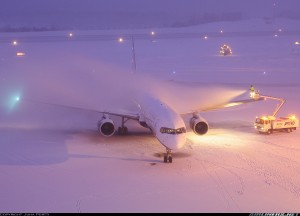Airplanes have been flying in winter conditions for 100+ years, and we have learned how to do it safely.
In theory, ice on the wing does cause problems in the generation of lift (the rough surface of the wing causes airflow separation earlier over the camber of the airfoil, thereby reducing lift), but solutions have been found…

An airliner being “de-iced.”
If it is snowing, or has been snowing, the airplane will be “de-iced”, which involves spraying it with a solution of hot anti-freeze liquid. This melts any snow/ice on the airplane (the wings being the most critical part), and prevents build-up of new ice for a period of time.
These liquids vary in properties and are chosen based on the particular environmental conditions at the time (temperature, rate of precipitation etc.). All provide protection for a period of time (called the “holdover time” in aviation parlance), and if we takeoff within that time there is no problem.
From time to time, depending on the airport and it’s own traffic problems (for example, JFK, where I have flown many times sometimes is so busy it takes 90 minutes from pushback to takeoff), your pilots may need to de-ice again.
No matter… the physics of the liquids vs. environmental conditions vs. time delay are well understood, and the time period cutoffs are non-negotiable.
So, rest assured… the cleverness and good sense of humans with their butts strapped in tin-cans has ensured that we have learned how to do it safely.
 Of course, sometimes the weather conditions exceed our ability to operate safely… in which case your flight will be cancelled. In such circumstances there will be bleaters (“I gotta get home… we gotta fly!”), but such decisions are also non-negotiable. If the conditions are too bad, we will not fly.
Of course, sometimes the weather conditions exceed our ability to operate safely… in which case your flight will be cancelled. In such circumstances there will be bleaters (“I gotta get home… we gotta fly!”), but such decisions are also non-negotiable. If the conditions are too bad, we will not fly.
We’re only going to fly if we believe it is 100% safe, and we have much experience in flying in weather that you, with your untrained eye, might see as questionable.
Fear not… cold as it is, it will be safe!